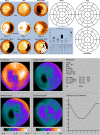The transformational potential of molecular radiomics
- PMID: 36238997
- PMCID: PMC10122929
- DOI: 10.1002/jmrs.626
The transformational potential of molecular radiomics
Abstract
Conventional radiomics in nuclear medicine involve hand-crafted and computer-assisted regions of interest. Recent developments in artificial intelligence (AI) have seen the emergence of AI-augmented segmentation and extraction of lower order traditional radiomic features. Deep learning (DL) affords the opportunity to extract abstract radiomic features directly from input tensors (images) without the need for segmentation. These fourth-order, high dimensional radiomics produce deep radiomics and are well suited to the data density associated with the molecular nature of hybrid imaging. Molecular radiomics and deep molecular radiomics provide insights beyond images and quantitation typical of semantic reporting. While the application of molecular radiomics using hand-crafted and computer-generated features is integrated into decision-making in nuclear medicine, the acceptance of deep molecular radiomics is less universal. This manuscript aims to provide an understanding of the language and principles associated with radiomics and deep radiomics in nuclear medicine.
Keywords: Artificial intelligence; artificial neural network; convolutional neural network; deep learning; deep radiomics; molecular imaging; nuclear medicine; radiomics.
© 2022 The Authors. Journal of Medical Radiation Sciences published by John Wiley & Sons Australia, Ltd on behalf of Australian Society of Medical Imaging and Radiation Therapy and New Zealand Institute of Medical Radiation Technology.
Figures







References
-
- Currie G, Hawk KE, Rohren E, Vial A, Klein R. Machine learning and deep learning in medical imaging: intelligent imaging. J Med Imaging Radiat Sci 2019; 50: 477–87. - PubMed
-
- Currie G. Intelligent Imaging: artificial intelligence augmented nuclear medicine. J Nucl Med Technol 2019; 47: 217–22. - PubMed
-
- Currie G. Intelligent Imaging: anatomy of machine learning and deep learning. J Nucl Med Technol 2019; 47: 273–81. - PubMed
-
- Currie G, Rohren E. Intelligent imaging in nuclear medicine: the principles of artificial intelligence, machine learning and deep learning. Semin Nucl Med 2021; 51: 102–11. - PubMed
-
- Currie G, Hawk KE, Rohren E. Ethical principles for the application of artificial intelligence (AI) in nuclear medicine and molecular imaging. Eur J Nucl Med Mol Imaging 2020; 47: 748–52. - PubMed
Publication types
MeSH terms
LinkOut - more resources
Full Text Sources
Medical

